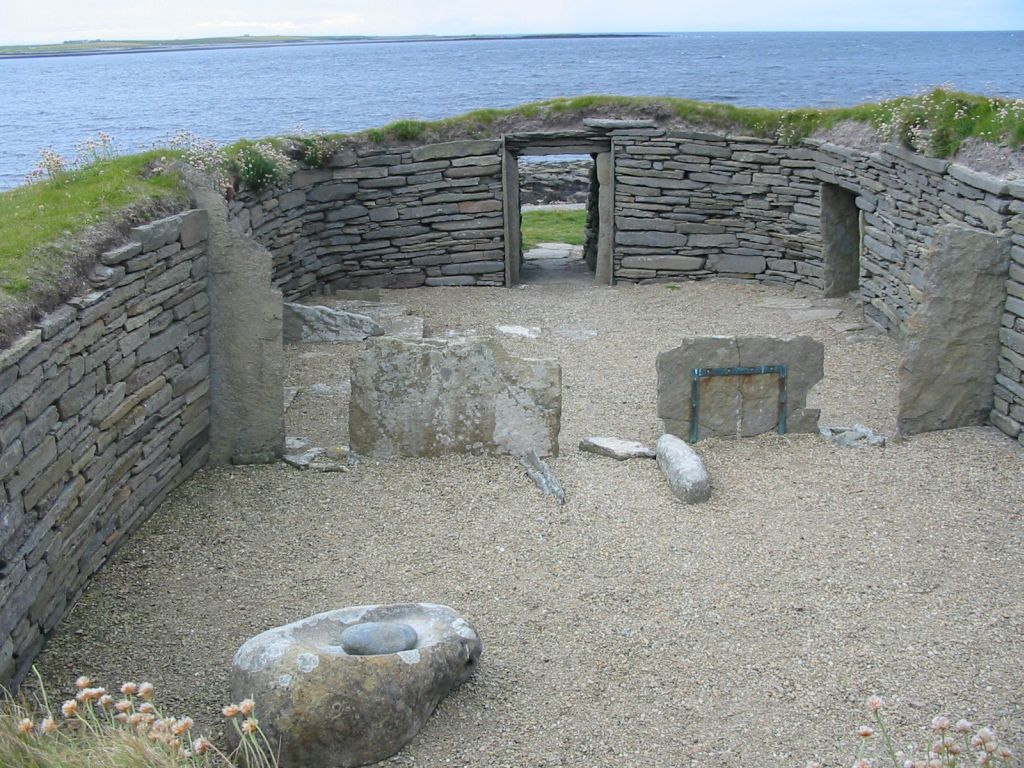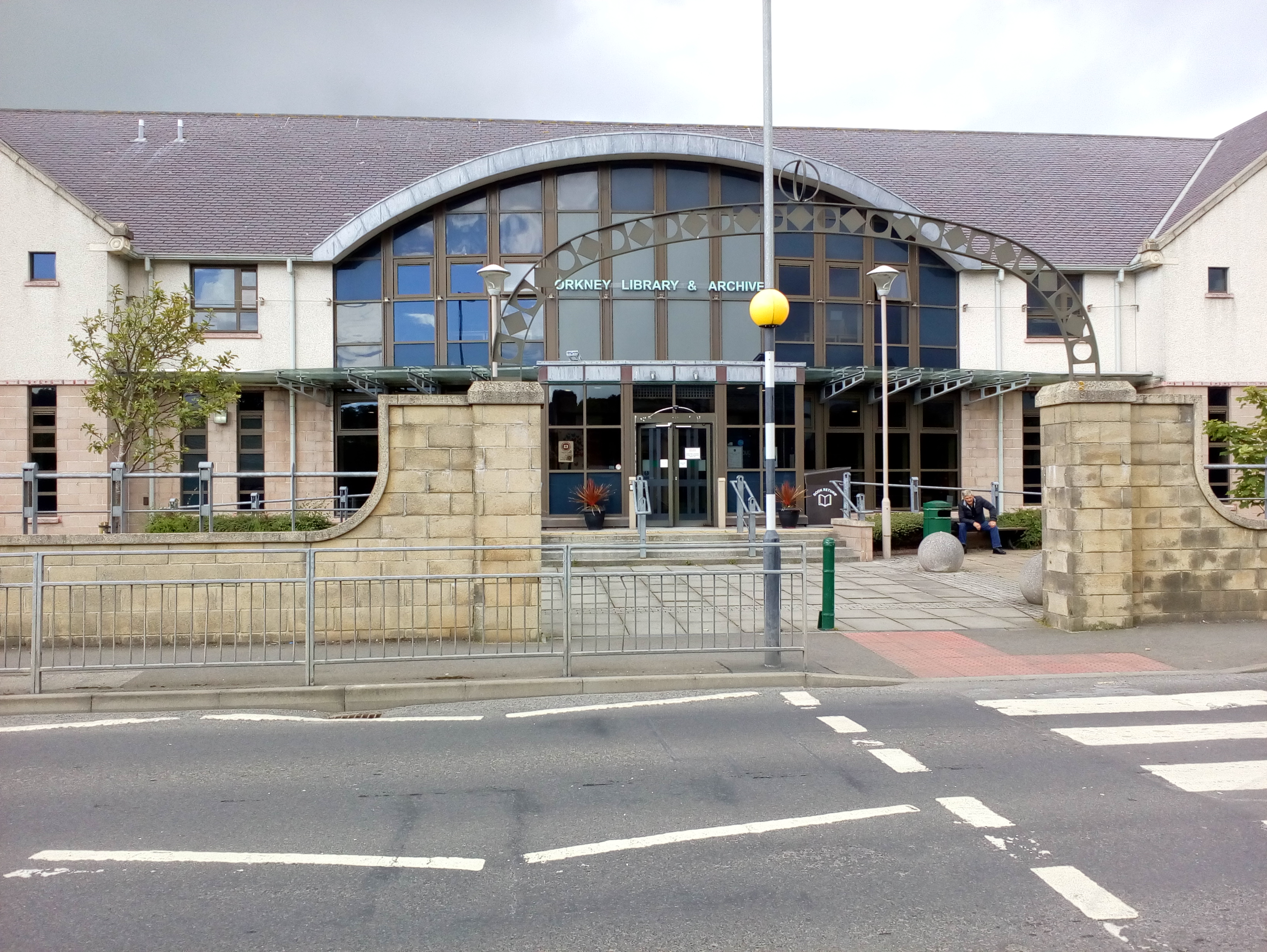|
Papa Stronsay
Papa Stronsay ( sco, Papa Stronsee; non, Papey Minni) is a small island in Orkney, Scotland, lying north east of Stronsay. It is in size, and above sea level at its highest point. After being largely abandoned, the island was bought at the end of the 20th century by traditionalist Catholic monks of the Sons of the Most Holy Redeemer, who operate a monastery and farm there. According to folklore, some of the natives were descended from a female selkie. This was because they had horny skin on their feet and hands, and permanently smelt of fish. Geography and geology The geology is middle old red sandstone. A thin tongue of land curls west from the main part of the island, and then south to form the Point of the Graand (a local word meaning a "sandbar"). The island in general is low lying, reaching a mere at its highest point. There is an light beacon in the north east. History The island has remains of two chapels. One dates from the eleventh century, and an eighth-century ... [...More Info...] [...Related Items...] OR: [Wikipedia] [Google] [Baidu] |
Papar
The Papar (; from Latin ''papa'', via Old Irish, meaning "father" or "pope") were, according to early Icelandic sagas, Irish monks who took eremitic residence in parts of what is now Iceland before that island's habitation by the Norsemen of Scandinavia, as evidenced by the sagas and recent archaeological findings. Origins The first Norsemen began settling in Iceland in 874 CE. The oldest Scandinavian source mentioning the existence of the Papar, however, the ''Íslendingabók'' ("Book of the Icelanders") by Icelandic chronicler Ari Þorgilsson, was written between 1122 and 1133, some time after the event. Ari writes of "Christian men", titled the 'Papar' by the Norsemen, who departed the isle because of their dislike of the 'heathen' Norse, pointing to the possibility of the Papar having arrived before the Norse. An earlier source that could possibly refer to the Papar is the work of Dicuil, an early 9th-century Irish monk and geographer, which included mention of the w ... [...More Info...] [...Related Items...] OR: [Wikipedia] [Google] [Baidu] |
Papa Westray
Papa Westray () ( sco, Papa Westree), also known as Papay, is one of the Orkney Islands in Scotland, United Kingdom. The fertile soilKeay, J. & Keay, J. (1994) ''Collins Encyclopaedia of Scotland''. London. HarperCollins. has long been a draw to the island. Attractions on the island include Holland House with an associated folk museum and the Knap of Howar Neolithic farmstead run by Historic Scotland. It is the ninth largest of the Orkney Islands with an area of . The island's population was 90 as recorded by the 2011 census, an increase of over 35% since 2001 when there were only 65 usual residents. During the same period, Scottish island populations as a whole grew by 4% to 103,702. Infrastructure Orkney Ferries sail from Papa Westray to Pierowall's Gill Pier. Twice a week - on Tuesday and Friday - the or provides a direct service to and from Kirkwall on the Orkney Mainland, also serving either Rapness on Westray, or North Ronaldsay. There are also occasional summer ... [...More Info...] [...Related Items...] OR: [Wikipedia] [Google] [Baidu] |
Deacon
A deacon is a member of the diaconate, an office in Christian churches that is generally associated with service of some kind, but which varies among theological and denominational traditions. Major Christian churches, such as the Catholic Church, the Oriental Orthodox Churches, the Eastern Orthodox Church, the Scandinavian Lutheran Churches, the Methodist Churches, the Anglican Communion, and the Free Church of England, view the diaconate as an order of ministry. Origin and development The word ''deacon'' is derived from the Greek word (), which is a standard ancient Greek word meaning "servant", "waiting-man", "minister", or "messenger". It is generally assumed that the office of deacon originated in the selection of seven men by the apostles, among them Stephen, to assist with the charitable work of the early church as recorded in Acts of the Apostles chapter 6. The title ''deaconess'' ( grc, διακόνισσα, diakónissa, label=none) is not found in the Bible ... [...More Info...] [...Related Items...] OR: [Wikipedia] [Google] [Baidu] |
Thorfinn The Mighty
Thorfinn Sigurdsson (1009?– 1065), also known as Thorfinn the Mighty ( Old Norse: ''Þorfinnr inn riki''), was an 11th-century Jarl of Orkney. He was the youngest of five sons of Jarl Sigurd Hlodvirsson and the only one resulting from Sigurd's marriage to a daughter of Malcolm II of Scotland. He ruled alone as jarl for about a third of the time that he held the title and jointly with one or more of his brothers or with his nephew Rögnvald Brusason for the remainder. Thorfinn married Ingibiorg Finnsdottir, daughter of Finn Arnesson, Jarl of Halland. The '' Heimskringla'' of Icelandic historian Snorri Sturluson, and the anonymous compiler of the '' Orkneyinga Saga'' wrote that Thorfinn was the most powerful of all the jarls of Orkney and that he ruled substantial territories beyond the Northern Isles. A sizeable part of the latter saga's account concerns his wars with a "King of Scots" named Karl Hundason whose identity is uncertain. In his later years he went on a pi ... [...More Info...] [...Related Items...] OR: [Wikipedia] [Google] [Baidu] |
Stiklestad
Stiklestad is a village and parish in the municipality of Verdal in Trøndelag county, Norway. It is located east of the town of Verdalsøra and about southeast of the village of Forbregd/Lein. The village is mainly known as the site of the Battle of Stiklestad on 29 July 1030. Stiklestad Church is located in the village and it is assumed to have been erected on the exact spot where King Olaf II Haraldsson fell in the battle. The king was buried in Nidaros (Trondheim), canonised there on 3 August 1031, and later enshrined in Nidaros Cathedral. Following the Lutheran reformation of 1537 the saint's remains were removed and their precise resting-place has been unknown since 1568. Name The Old Norse form of the name is ''Stiklarstaðir''. The first element is the genitive of a word ''stikl'' and the last element is ''staðir'' which means "farm". The word ''stikl'' might have been derived from the verb ''stikla'' which means "to jump", and this might have been the name of a ... [...More Info...] [...Related Items...] OR: [Wikipedia] [Google] [Baidu] |
Olaf II Of Norway
Olaf II Haraldsson ( – 29 July 1030), later known as Saint Olaf (and traditionally as St. Olave), was King of Norway from 1015 to 1028. Son of Harald Grenske, a petty king in Vestfold, Norway, he was posthumously given the title '' Rex Perpetuus Norvegiae'' ( en, Eternal/Perpetual King of Norway) and canonised at Nidaros (Trondheim) by Bishop Grimkell, one year after his death in the Battle of Stiklestad on 29 July 1030. His remains were enshrined in Nidaros Cathedral, built over his burial site. His sainthood encouraged the widespread adoption of Christianity by Scandinavia's Vikings/Norsemen. Pope Alexander III confirmed Olaf's local canonisation in 1164, making him a recognised saint of the Catholic Church and started to be known as ''Rex Perpetuus Norvegiae'' – ''eternal king of Norway''. Following the Reformation he was a commemorated historical figure among some members of the Lutheran and Anglican Communions. The saga of Olav Haraldsson and the legend of Ola ... [...More Info...] [...Related Items...] OR: [Wikipedia] [Google] [Baidu] |
Malt
Malt is germinated cereal grain that has been dried in a process known as " malting". The grain is made to germinate by soaking in water and is then halted from germinating further by drying with hot air. Malted grain is used to make beer, whisky, malted milk, malt vinegar, confections such as Maltesers and Whoppers, flavored drinks such as Horlicks, Ovaltine, and Milo, and some baked goods, such as malt loaf, bagels, and Rich Tea biscuits. Malted grain that has been ground into a coarse meal is known as "sweet meal". Malting grain develops the enzymes (α-amylase, β-amylase) required for modifying the grains' starches into various types of sugar, including monosaccharide glucose, disaccharide maltose, trisaccharide maltotriose, and higher sugars called maltodextrines. It also develops other enzymes, such as proteases, that break down the proteins in the grain into forms that can be used by yeast. The point at which the malting process is stopped affects th ... [...More Info...] [...Related Items...] OR: [Wikipedia] [Google] [Baidu] |
Christmas
Christmas is an annual festival commemorating the birth of Jesus Christ, observed primarily on December 25 as a religious and cultural celebration among billions of people around the world. A feast central to the Christian liturgical year, it is preceded by the season of Advent or the Nativity Fast and initiates the season of Christmastide, which historically in the West lasts twelve days and culminates on Twelfth Night. Christmas Day is a public holiday in many countries, is celebrated religiously by a majority of Christians, as well as culturally by many non-Christians, and forms an integral part of the holiday season organized around it. The traditional Christmas narrative recounted in the New Testament, known as the Nativity of Jesus, says that Jesus was born in Bethlehem, in accordance with messianic prophecies. When Joseph and Mary arrived in the city, the inn had no room and so they were offered a stable where the Christ Child was soon born, with angel ... [...More Info...] [...Related Items...] OR: [Wikipedia] [Google] [Baidu] |
Yule
Yule, actually Yuletide ("Yule time") is a festival observed by the historical Germanic peoples, later undergoing Christianised reformulation resulting in the now better-known Christmastide. The earliest references to Yule are by way of indigenous Germanic month names ' (Before Yule) or ' and ' (After Yule). Scholars have connected the celebration to the Wild Hunt, the god Odin and the pagan Anglo-Saxon Mōdraniht. Terms with an etymological equivalent to ''Yule'' are used in the Nordic countries for Christmas with its religious rites, but also for the holidays of this season. ''Yule'' is also used to a lesser extent in English-speaking countries to refer to Christmas. Customs such as the Yule log, Yule goat, Yule boar, Yule singing, and others stem from Yule. A number of Neopagans have introduced their own rites. Etymology ''Yule'' is the modern English representation of the Old English words ' or ' and ' or ''ġéoli'', with the former indicating the 12-day festiv ... [...More Info...] [...Related Items...] OR: [Wikipedia] [Google] [Baidu] |
Kirkwall
Kirkwall ( sco, Kirkwaa, gd, Bàgh na h-Eaglaise, nrn, Kirkavå) is the largest town in Orkney, an archipelago to the north of mainland Scotland. The name Kirkwall comes from the Norse name (''Church Bay''), which later changed to ''Kirkvoe'', ''Kirkwaa'' and ''Kirkwall''. Kirkwall was formerly the site of an ancient Norse town founded approximately 1000 years ago. Today, it is a transport hub with ferries to many locations. History The town was first mentioned in in the year 1046, when it was recorded as the residence of , the Earl of Orkney, who was killed by his uncle Thorfinn the Mighty. In 1486, King James III of Scotland elevated Kirkwall to the status of a royal burgh. On the western edge of the town, surrounded by Hatston Industrial Estate, there is a prehistoric monument, known as the "Grain Earth House" (see Historic Scotland). It is a short, low, stone-walled passage, deep underground, leading to a small pillared chamber. This kind of earth house (or "souterrai ... [...More Info...] [...Related Items...] OR: [Wikipedia] [Google] [Baidu] |
Rögnvald Brusason
Rognvald Brusason (died 1046), son of Brusi Sigurdsson, was Earl of Orkney jointly with Thorfinn Sigurdsson from about 1037 onwards. His life is recorded in the '' Orkneyinga Saga''. History Rognvald was taken by his father to Norway, to the court of Olaf Haraldsson, when Brusi and Thorfinn went there to have the inheritance of Einar Wry-mouth's third-share of the Earldom settled. Olaf kept Einar's share for himself, appointing Brusi to administer it, and kept Rognvald at his court. The ''Orkneyinga Saga'' says of Rognvald:Rognvald was one of the handsomest of men, with a fine head of golden hair, smooth as silk. At an early age he grew to be tall and strong, earning a great reputation for his shrewdness and courtesy ... Rognvald was a supporter of Olaf Haraldsson, later Saint Olaf, sharing his exile in Kievan Rus, and helping his brother Harald Sigurdsson, better known as Harald Hardraade, escape after the Battle of Stiklestad in 1030. While Harald went on to Constantinople, ... [...More Info...] [...Related Items...] OR: [Wikipedia] [Google] [Baidu] |






.jpg)
